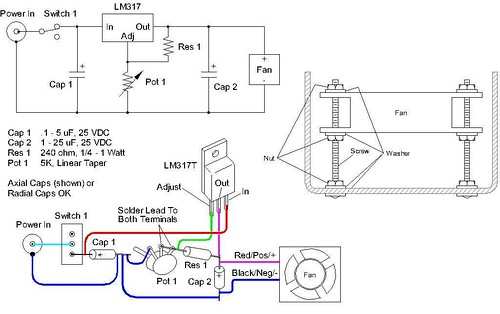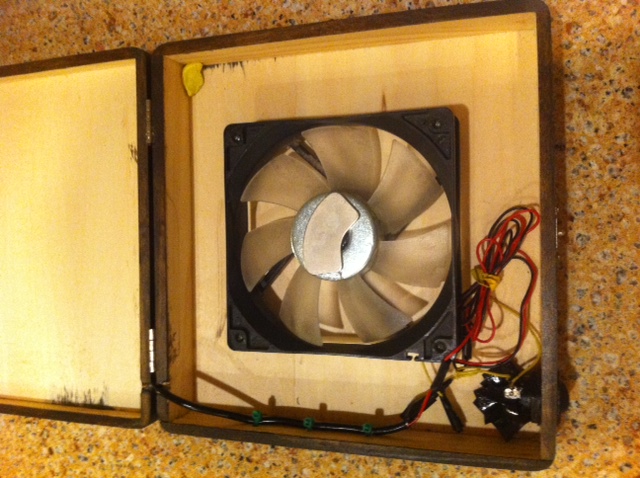Greatest stir plate enclosure ever...I'm looking every time I hit a thrift store!
do you have to blow on it to make it work?

Greatest stir plate enclosure ever...I'm looking every time I hit a thrift store!
do you have to blow on it to make it work?
This is a fool proof wiring diagram. All parts is obtainable from your local Radio Shack.

This will allow for perfect speed control. Using just a potentiometer will work at first but wont last and last. You wont get good speed control and using lower volt DC adapters for speed control is silly. Don't do it, build it right.
Also checkout this handy link: http://www.stirstarters.com/instructions.html
If you like DIY then build one if not just order one from here, it is much easier and only marginally more expensive than parting and building it yourself.
Cheers to happy yeasty beasties!
It also looks like my next upgrade is a 3L or 4L flask because my 1 gallon jug doesn't have a flat interior bottom.
Great thread.
I bet somewhere along the way a major stir plate manufacturer happened upon this thread, did a "D'oh !" and forehead slap and said "so this is where our stire plate sales have been going" !












![Craft A Brew - Safale S-04 Dry Yeast - Fermentis - English Ale Dry Yeast - For English and American Ales and Hard Apple Ciders - Ingredients for Home Brewing - Beer Making Supplies - [1 Pack]](https://m.media-amazon.com/images/I/41fVGNh6JfL._SL500_.jpg)


When it is a hobby and you are doing it for fun, you can't count your time as cost. That's part of the hobby. How many hobbies do you know where there can actually be a cost savings?If you think about it, we're not really building these for less money. We're just not assigning a dollar figure to the time we spend assembling. If someone asked to pay you to spend all day building these, the dollar figure would go up a bit!
Since you say you swapped the pot, then the only thing left is the voltage regulator. Have you tested the output with a meter?Hi Guys,
I have built 2 stir plates using this schematic. The first stir plate worked perfect. I couldn't be happier. The second stir plate works but the potentiometer basically is off when turned down and if you turn it a little bit the fan goes from off to full speed.
I read and re-read this schematic, checked it against my wiring and everything looks right. I swapped pots, switches, and power supplies (one used a 12v and the other a 5v) but none of those were the problem. It's somewhere in the circuit but seemingly not the wiring. I am thinking it might be a bad resistor but I am totally out of ideas. Can anyone think of what component or area of the circuit might be the problem to cause a pot to have no adjustability in this circuit?
Thanks in advance.
Hovik
Pot goes from 1.2 ohms - 4.95k ohms. This is very close to the performance of the pot in my working stir plate. Wall wort output is 5.10v. Input side of regulator shows 5.10vSince you say you swapped the pot, then the only thing left is the voltage regulator. Have you tested the output with a meter?
My first thought would have been the pot. Either it is bad and going from off straight to full on, or the value is not what you think it is. If the pot is bigger than you think, that is exactuly what it would do.
If the pot checks out, put the volt meter on the output (without the fan) and watch the voltage change as you turn the pot.
Another thing to check is that the terminals are correct on the 317 regulator. If the input and output are swapped, that might cause the problem too.
According to Mellow52, a pot alone wont last and last. I'm not sure why, I've never heard that before. I'm not an engineer so if there is a reason that current control is not as good as voltage control, I would like to understand. Functionally, they both see to be the same.
Most DIY's if heard of have been with a pot alone. In my case, I used a transistor and pot combination because I couldn't find the right sized pot locally. Same effect as a pot alone but mine seems to be holding up just fine.
Good Luck, let us know what you find
That's not the magnet, but the actual disc that holds the data. The magnet should be under that arm that comes out to write on the disc if im not mistaken.
So many beers... so little time.

Lol, ok I knew what the disk was, but I thought the magnet was the smaller center part. Somehow I thought those was attached to the disk themselves.
Well, now the next question is, since these appear to be just as brittle as everyone said they would be, could I break off the larger unbroken magnet to match the other one I broke, or keep searching for another hard drive to destroy. lol Crap sake I barely put the needle nose pliers to them and it broke like glass.

Well, now the next question is, since these appear to be just as brittle as everyone said they would be, could I break off the larger unbroken magnet to match the other one I broke, or keep searching for another hard drive to destroy. lol Crap sake I barely put the needle nose pliers to them and it broke like glass.
Pot goes from 1.2 ohms - 4.95k ohms. This is very close to the performance of the pot in my working stir plate. Wall wort output is 5.10v. Input side of regulator shows 5.10v
Output shows 1.254vdc when pot closed, only 3.51vdc when is pot open but this is with the fan connected. If I need to desolder it to get a reading I can... let me know. Does this suggest any possible causes?
I checked and the volt regulator seems to be wired correct.
This is a fool proof wiring diagram. All parts is obtainable from your local Radio Shack.

This will allow for perfect speed control. Using just a potentiometer will work at first but wont last and last. You wont get good speed control and using lower volt DC adapters for speed control is silly. Don't do it, build it right.
Also checkout this handy link: http://www.stirstarters.com/instructions.html
If you like DIY then build one if not just order one from here, it is much easier and only marginally more expensive than parting and building it yourself.
Cheers to happy yeasty beasties!
ok, I'm not sure if it's just me but I can't find most of these items at radioshack. I was able to find the 5k potentiometer and the LM317T. However I wasn't able to find the 5 or 25 uf 25vdc capacitors, or the 240 ohm, 1/4 - 1 watt resistor. I ended up getting the 220 ohm, 1/4-watt resistor since it seemed the closest. Any suggestions? I think I did see a 4.7 uf capacitor but it wasn't 25vdc either.
Will any size fan work I have a like a two inch it seems to run fast enough. Trying to make it a inexpensive as possible...
I'm having trouble finding a Potentiometer/Rheostat. I live in Canada so shipping for everywhere I look bring the price to around $30 and I can't find any local shops that stock them. Any Canadians have a website that won't cost me an arm and a leg for shipping?
I'm having trouble finding a Potentiometer/Rheostat. I live in Canada so shipping for everywhere I look bring the price to around $30 and I can't find any local shops that stock them. Any Canadians have a website that won't cost me an arm and a leg for shipping?